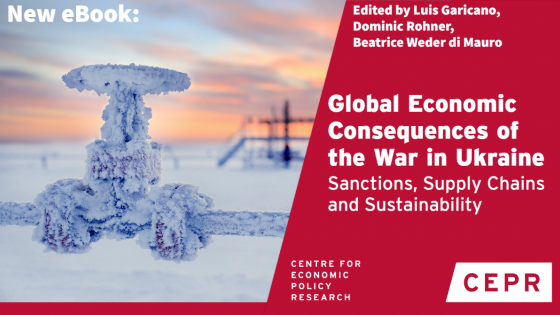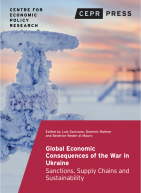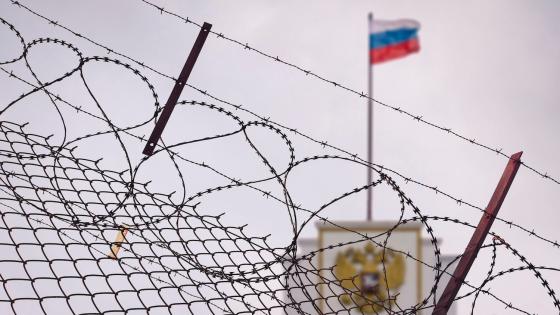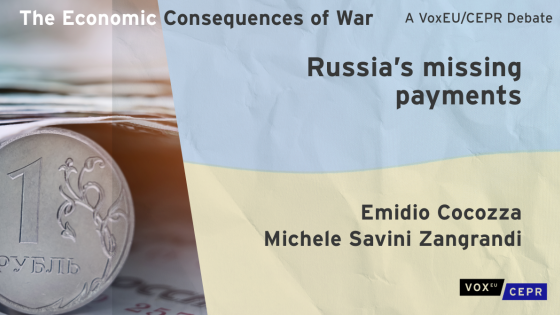Local suffering and possible global consequences
The first and most important consequence of the war is the massive loss of human life. The Ukrainian population has suffered terribly while fighting off the attack by one of the world's most powerful armies with courage and determination. According to the UN High Commissioner for Human Rights, from its beginning up to 4 September, the war had caused an estimated 13,917 civilian casualties in the country (of which 5,718 killed and 8,199 injured).
The US government estimated in August military casualties among the invading Russian forces at around 20,000 killed and perhaps 50,000 -60,000 wounded, and a slightly smaller number on the Ukrainian side.
The economic losses are enormous and take many forms. The simplest measures are consumption losses. Oleksiy Blinov and Simeon Djankov (Chapter 25), using bank card activity, show that private consumption in Ukraine fell by half during the first month of the war and then recovered half of the loss, up to 70–74% of the previous year’s level by June.
A macroeconomic crisis is looming because the Ukrainian government has been forced to partially finance the war with an inflation tax. Revenues only cover about a third of the Ukrainian government’s monthly deficit of $5 billion; another third is being covered by loans and grants; and the rest by the central bank. Promised financial support from the West has been falling short, inflation in the Ukraine has been accelerating and the fixed exchange rate is unsustainable (Becker et al. 2022).
Noam Angrist, Simeon Djankov, Pinelopi Goldberg and Harry Patrinos (Chapter 26) and Tilman Brück, Michele Di Maio and Sami Miaari(Chapter 27) highlight enormous losses of education that risk having persistent effects. And as Sascha Becker points out (Chapter 28), there are the huge costs from the internal and external displacement of over 10 million Ukrainians due to the war. Investing in the human capital of these refugees is crucial.
Economic consequences of the sanctions
Sanctions have been deployed incrementally over the last years and increasingly appear to be the economic weapon of choice, as demonstrated by Gabriel Felbermayr, Aleksandra Kirilakha, Constantinos Syropoulos, Erdal Yalcin and Yoto Yotov (Chapter 5). The effectiveness of financial sanctions on Russia has been disputed. An often-cited indicator of ineffectiveness has been the ruble exchange rate. Russia’s currency depreciated sharply, losing almost half of its value in March, but has since recovered to the pre-war level. Oleg Itskhoki and Dmitry Mukhin (Chapter 6) argue instead that the ruble appreciation is the result of the effective sanctions on Russian imports, which lowered demand for foreign currency, as well as financial repression. Similarly, Mark Harrison (Chapter 3) argues that import sanctions are effective, since Russia is unable to spend its growing export revenues and is simply accumulating financial claims on Western economies through energy sales which it cannot use.
Financial sanctions on Russia have been imposed sequentially since the annexation of the Crimea in 2014. Studies on the real and financial effects of these previous sanctions support a more sceptical view. Mikhail Mamonov, Anna Pestova and Steven Ongena (Chapter 4) find that Russian banks largely anticipated global sanctions and not sanctioned banks were partly able to compensate for them. Anna Pestova, Mikhail Mamonov and Steven Ongena (Chapter 11) show that those sanctions had some measurable, but small, effects on Russian firms.
The high dependence of many European countries meant that they continued to buy gas and oil from Russia while at the same time attempting to refill their storages and diversify energy suppliers-hence the war is being paid largely through higher prices charged to citizens around the world, even if they are opposed to the war. This is the reason for the many calls for a full embargo on Russian energy (see Chapter 10 by Anette Hosoi and Simon Johnson).
Some were worried a full embargo would be too costly. But a paper written by group of economists (see Chapter 15 by Rüdiger Bachmann et al.) was the first to estimate the macroeconomic effects in a multi-sector macro model (specifically, the one by Baqaee and Fahri 2021) and found the cost of a full gas embargo on the German economy substantial but manageable, at below 3% of GDP. Smaller sized effects were estimated for France.
Short of an embargo, there are two tools that can be used: import tariffs and price caps. Philippe Martin and Beatrice Weder di Mauro (Chapter 1) argue that a combination of these two would be the best European response for several reasons. They explain that given the structure of demand and of buyers and suppliers in the market, an import tariff on Russian oil would best serve to reduce the rents that Russia receives from these sales. For gas, the best strategy for Europe is to organise a single buyer that sets a price cap on pipeline gas for Russia and other gas providers. By contrast, a general gas price cap at the retail level is not the best tool to shield households and firms, since it is not sufficiently targeted and does not provide incentives to save and adapt.
World trade war and disrupted supply chains?
In the short term, the war is adding to the stress of global value chains, which have still not recovered from the pandemic shock – whether manufacturing or agricultural. Deborah Winkler and Lucie Wuester (Chapter 17) study the position and role of Russia in global value chains. They point out that the country sits very high in those value chains – exporting raw materials (mostly metals) and chemicals and energy (notably, coke and petroleum). Hence, disruptions to trade with Russia have a global impact through price hikes, notably for energy goods, which affect transportation costs and virtually all global value chains.
Alvaro Espitia, Simon Evenett, Nadia Rocha and Michele Ruta (Chapter 19) worry about the impact of policy interventions in terms of worsening the war-related losses due to trade disruptions. Supply chain distortions multiply as they extend. Michele Ruta (Chapter 18) notes that inertia is likely to preserve supply chains, and that even when substitution takes place from one country to another, it is unlikely to affect costs significantly. It is only the misguided reactions by governments, inducing autarky and reshoring, that lead to very significant losses in productivity and high economic costs.
How persistent are these costs likely to be? Tobias Korn and Henry Stemmler (Chapter 20) show in their chapter that when violence persists over time (as it already has in this war), the relocation effects caused by violence tend to persist in the long run. Once relocation away from a certain supplier or buyer takes place, it remains after peace is established. Thus, supply chains are likely to remain permanently altered by the conflict, away from Ukraine and Russia.
Impact on developing countries
Poverty is a main driver of conflict. This has been shown in dozens of studies exploiting adverse income shocks (Miguel et al. 2004, Jia 2014, König et al. 2017).
There is a significant and growing risk that we will soon see soaring food prices in developing countries that will impoverish parts of the population and trigger a heightened risk of social unrest. As Erhan Artuc, Guillermo Falcone, Guido Port and Bob Rijkers (Chapter 24) note, Ukraine and Russia combined account for over a quarter of global wheat exports, and Ukraine alone accounts for 14% of global corn exports. As a result, prices have soared and are expected to remain high. Using a simulation tool, Artuc et al. estimate welfare impacts of up to a 10% loss (Armenia’s case) for the poorer 40% of the population, with an average of almost 2% loss in welfare for that population. The burden is large, and the impact is disproportionately in the South. In a separate simulation, also including energy prices, Maksym Chepeliev, Maryla Maliszewska and Maria Filipa Seara e Pereira (Chapter 22) find drops of a similar magnitude in real income in developing countries of around 1% of GDP on average. Whereas energy is the main driver of the impact in high-income countries, more expensive food is the main source of the impact on poorer countries.
Using a new data set, Sebastian Horn, Carmen Reinhart and Christoph Trebesch (Chapter 23) show that China has become the most important official player in international sovereign debt renegotiations but that, except for symbolic debt cancelations of small zero-interest loans, Chinese lenders almost never provide deep debt relief with face value reduction.
Thus, low-income countries face a drop in financing on top of a huge increase in energy and food prices. The consequences are very concerning, as Eoin McGuirk and Marshall Burke (Chapter 21) show. The impact is very heterogeneous, depending on the net position of the individual countries. While countries that are net exporters may see an increase in prosperity and less conflict, net food and energy importers will likely see hunger, misery, food riots and an increase in inter-group conflict.
Political fallout and long-run impact on multilateralism and the global order
Concerning the trade architecture, the main potential consequence, as Eddy Bekkers and Carlos Góes (Chapter 31) argue, is the division of the world into two blocs: a Western-centric bloc and a China-centric bloc. How costly would such a division be? Using a simulation, the authors show that the costs are significant – 5% of world GDP on average and up to 10% for poorer countries. Hence, they argue, preserving the current trading system is essential.
Second, the unprecedented use of sanctions, as Markus Brunnermeier, Harold James and Jean-Pierre Landau (Chapter 30) argue, will have a long-term impact on the international monetary system, although it will leave the central role of the dollar in it unchanged, given its unique set of advantages.
Finally, the war is having profound effects in the European Union. The chapter by Kai Gehring (Chapter 29) shows that the Russian attacks on Ukraine in 2014 increased European identity and trust in European institutions. Of course, as he also points out, the jury is still out on whether this effect of closing ranks in Europe and the West will be permanent or will crumble if the costs of a prolonged war, winter energy insecurity, spiralling energy prices and inflation become more apparent.
Some upsides?
At this stage, most risks are on the downside. But we see one silver lining for the planet: the acceleration of the green energy transition. As discussed in Garicano, Rohner and Weder di Mauro (Chapter 32), although in the short run greenhouse gas emissions are increasing because of the war, it has become abundantly clear that energy provided by green sources yields a double dividend: limiting global warming and fostering energy security. High energy prices caused by the anticipation of fossil fuel sanctions and by damage to the energy infrastructure may accelerate investment in renewables and in energy efficiency and contribute to attenuating climate change.
References
Anderton, C H and J Brauer (2021), "Mass atrocities and their prevention", Journal of Economic Literature 59(4): 1240-92.
Baqaee, D and E Farhi (2021), “Networks, Barriers, and Trade”, working paper.
Garicano, L, D Rohner and B Weder di Mauro (2022), Global Economic Consequences of the War in Ukraine: Sanctions, Supply Chains and Sustainability, CEPR Press.
Jia, R (2014), "Weather shocks, sweet potatoes and peasant revolts in historical China”, The Economic Journal 124(575): 92-118.
König, M D, D Rohner, M Thoenig, and F Zilibotti (2017), "Networks in conflict: Theory and evidence from the Great War of Africa”, Econometrica 85(4): 1093-1132.
Miguel, E, S Satyanath, and E Sergenti (2004), "Economic shocks and civil conflict: An instrumental variables approach”, Journal of Political Economy 112(4): 725-753.
Rohner, D (2022), "Mediation, military and money: The promises and pitfalls of outside interventions to end armed conflicts”, Journal of Economic Literature.






